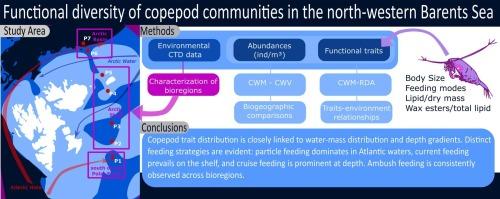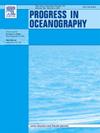Functional diversity of copepod communities in the north-western Barents Sea
IF 3.6
3区 地球科学
Q1 OCEANOGRAPHY
引用次数: 0
Abstract
Trait-based approaches offer a powerful alternative to traditional species-centred methods by offering a mechanistic understanding of complex ecosystems. This study investigates the functional diversity of copepod communities in the north-western Barents Sea with a focus on trait distribution, trade-offs, and the influence of local environmental conditions across latitudinal and depth gradients. Despite the ecological importance of copepods, the Arctic remains poorly characterized in these respects. To address this knowledge gap, we analysed the spatial diversity of copepods and identified potential trade-offs among three functional traits: body size, feeding strategy, and lipid content. Using community-weighted means, variances, and Redundancy Analysis, we examined trait-environment relationships across bioregions and depth layers in a shelf area expanding from warmer ice-free waters in the south to colder seasonal ice-covered waters in the north and into the basin. Our findings reveal distinct trait distributions: the region south of the Polar Front in warmer waters, copepods tend to be smaller, lipid-poor and predominantly particle feeders, characteristic of a detritus-based food web with higher trait variability. In contrast, the Arctic Shelf and Arctic Basin regions are dominated by larger, lipid-rich copepods with lower trait variances, reflecting strong environmental filtering. Ambush feeding is the prevalent strategy in surface waters across the transect, whereas cruise feeding and a high proportion of wax esters relative to total lipids are primarily observed in the deeper layers. This research enhances our understanding of the functional complexity of Arctic mesozooplankton communities and provides a baseline for predicting future potential regime shifts.

巴伦支海西北部桡足类群落的功能多样性
基于性状的方法通过提供对复杂生态系统的机制理解,为传统的以物种为中心的方法提供了强有力的替代方案。本文研究了巴伦支海西北部桡足类群落的功能多样性,重点研究了特征分布、权衡以及当地环境条件在纬度和深度梯度上的影响。尽管桡足类动物具有重要的生态意义,但北极在这些方面的特征仍然很差。为了解决这一知识差距,我们分析了桡足类动物的空间多样性,并确定了三个功能特征之间的潜在权衡:体型、摄食策略和脂质含量。利用群落加权方法、方差和冗余分析,我们研究了大陆架区域从南部温暖的无冰水域扩展到北部寒冷的季节性冰层覆盖水域并进入盆地的生物区域和深度层之间的性状-环境关系。我们的研究结果揭示了不同的特征分布:在极地锋以南的温暖水域,桡足类动物往往更小,脂肪更少,主要是颗粒捕食者,以碎屑为基础的食物网具有更高的特征变异性。相比之下,北极陆架和北极盆地地区以体型较大、富含脂质的桡足类动物为主,特征方差较小,反映出强烈的环境过滤作用。在整个样带的地表水中,伏击捕食是普遍的策略,而巡航捕食和蜡酯相对于总脂质的高比例主要在较深的地层中观察到。这项研究增强了我们对北极中浮游动物群落功能复杂性的理解,并为预测未来潜在的政权转变提供了基线。
本文章由计算机程序翻译,如有差异,请以英文原文为准。
求助全文
约1分钟内获得全文
求助全文
来源期刊

Progress in Oceanography
地学-海洋学
CiteScore
7.20
自引率
4.90%
发文量
138
审稿时长
3 months
期刊介绍:
Progress in Oceanography publishes the longer, more comprehensive papers that most oceanographers feel are necessary, on occasion, to do justice to their work. Contributions are generally either a review of an aspect of oceanography or a treatise on an expanding oceanographic subject. The articles cover the entire spectrum of disciplines within the science of oceanography. Occasionally volumes are devoted to collections of papers and conference proceedings of exceptional interest. Essential reading for all oceanographers.
 求助内容:
求助内容: 应助结果提醒方式:
应助结果提醒方式:


